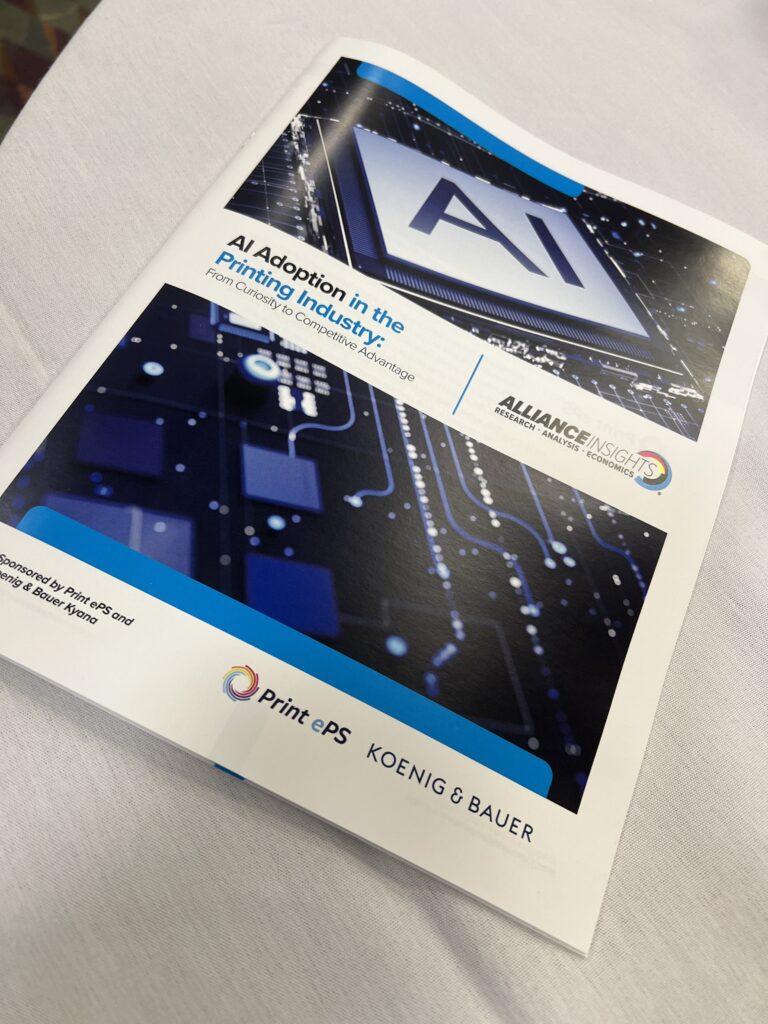Data from the AI Adoption in the Printing Industry report by PRINTING United Alliance reveals why print service providers can’t afford to wait for AI
Taken from a presentation by Nathan Safran, VP Research for PRINTING United Alliance

The adoption rate of Artificial Intelligence (AI), particularly generative AI, is unlike anything the tech world has ever seen. It reached 50% adoption in just two years—a speed that blows past electricity, the internet, and smartphones. This astonishing pace is not just a Silicon Valley trend; it’s the new reality for the print, graphics, and display industries.
Recent research from PRINTING United Alliance reveals that AI is not only critical for survival but is already delivering measurable ROI for the organisations embracing it today. For print service providers (PSPs) and display graphics companies, the question is no longer if you should adopt AI, but how fast you can implement it to secure a competitive edge.
85% say AI is critical to competitiveness
The study, “Artificial Intelligence in the Printing Industry: The Journey Begins,” underscores the industry’s consensus on the technology’s importance:
- 85% of print service providers (PSPs) agree that AI is critical to staying competitive.
- 83% agree that AI presents new business opportunities, moving beyond simple productivity boosts.
- A significant 42% believe they will not survive long-term without implementing AI.
This data reflects a palpable mix of excitement and challenge. While leaders are seeing huge gains, many PSPs are overwhelmed, wondering where to start and how to integrate this complex technology into existing, lean operations.
The barrier to entry is lower than you think
While concerns about technical complexity exist, the barriers to AI adoption are proving to be more surmountable than for past technologies:
| Top Barrier | Why it’s Changing Rapidly |
| Lack of industry-specific AI tools (46% major barrier) | Software and OEM vendors are heavily investing in and creating tailored solutions monthly. The gap between generic and industry-specific tools is shrinking fast. |
| Lack of understanding of AI capabilities | Education is the key, and it’s widely available. Unlike major infrastructure projects, learning can be done with low-cost, readily available online resources and industry-specific training. |
| Lack of proven use cases in the print industry | This perception is actively shifting. Early adopters are defining new, cutting-edge use cases that others can replicate (see case studies below). |
As the technology is iterated and updated quickly, it’s an advantage for PSPs to understand that AI is not a massive, fixed infrastructure project, but an evolving toolset that requires an adaptive, experimental mindset.
From cost centre to profit centre
The most fascinating insight from the research is AI’s ability to turn traditional cost centres into profit contributors.
When looking at who is using generative AI applications like content creation, writing, and design, an impressive 22% of users are reporting that these applications helped them increase overall profitability.
For a PSP with a lean marketing team, leveraging AI to create compelling blog posts, website copy, or lead-gen materials allows them to drive traffic and educate customers, effectively turning a time-consuming marketing cost into a top-of-funnel revenue driver.
The roadmap of the AI leader
The research identified a clear divide between “AI Leaders” and “Laggards.” Leaders don’t just experiment—they have a formal plan:
| AI Leaders | AI Laggards |
| 46% have a clear AI roadmap (a cross-departmental strategy). | The majority lack a clear plan. |
| 9 out of 10 assign clear responsibility for AI initiatives. | Nearly half have no one responsible, treating it as a sideline experiment. |
| 50% purchase multiple AI solutions to test and iterate. | Tend to stick to one or none. |
Leaders are creating multi-disciplinary, cross-functional committees that meet with every department (sales, marketing, operations) to identify the highest-impact pain points. This smart approach ensures AI investment solves real business problems, rather than simply adopting technology for its own sake.
The payoff is tangible ROI across the board
The ultimate takeaway is the dramatic difference in business outcomes between those with a plan and those without. AI Leaders report seeing significantly higher benefits than Laggards across every measured metric:
- Productivity: Leaders report substantially higher gains in production efficiency and freeing up staff for more competitive tasks.
- Cost Savings: Better forecasting and process automation lead to tangible cost reductions.
- Speed: Simple tasks like estimating, which historically took hours, are being slashed to minutes (see case study below).
- Quality & CX: Leaders are seeing improved sales and marketing results, along with a better overall customer experience.
Case study snapshot: Cutting Hours to Minutes
| Company Profile | AI Application | Key Impact |
| Commercial Printer ($20–$40M Sales) | Operational AI for shipping, estimating, and process pathing. | Cut estimates from four hours to just two minutes. Provides transparent profitability and margin evaluation per product/customer. |
| Small Printer ($3–$5M Sales) | Internal development of a custom “scorecard” using machine learning. | Forecasts labour, capacity, and payroll in real-time for a holistic operational view. |
The key is to start small and target major pain points. Whether it’s the large industry giants creating customer-facing AI platforms or small PSPs developing internal scheduling scorecards, the message is clear: AI is delivering faster work, smarter decisions, and measurable ROI.
Treat AI as a core business strategy
For any PSP looking to move from laggard to leader, the PRINTING United Alliance suggests the following:
- Treat AI as an Imperative: It is a core business strategy, not just a niche IT initiative.
- Educate Continuously: CEOs and leadership must be at the forefront of learning and experimenting.
- Implement, Observe, and Adjust: Don’t be afraid to try multiple tools, kill those that don’t work, and iterate on those that do.
To help the industry bridge the gap between research and implementation, the Alliance has launched a new resource, including PRINTING United AI Consulting Services. This service offers the technical expertise to guide PSPs through the deployment process, completing the circle from essential research to actionable implementation plans.
The future of display and print is being shaped by AI—those who act first will define it.

